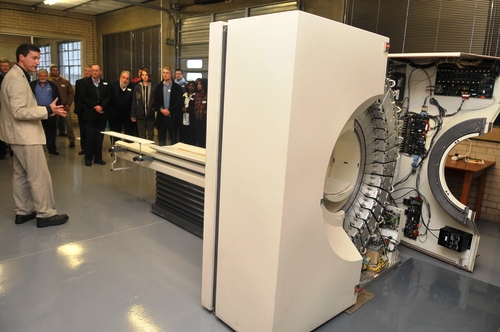Positron Emission Particle Tracking (PEPT) is a technique for studying the flow of particulate systems such as tumbling mills in the minerals industry. Initially developed for the medical imaging industry, positron emission tomography has been adapted for engineering applications at the University of Birmingham. The particular value of PEPT is the ability to look deep within the particulate system for extended periods of time, thereby elucidating the in-situ kinematics and dynamics of the flow.
The basic principle of PEPT is based on positron annihilation. A single particle is labelled with a radionuclide that decays via beta-plus decay, resulting in two gamma rays, each of energy 511 keV travelling in exactly opposite directions. Simultaneous detection of the two gamma rays in an array of detectors defines a line along which the annihilation occurred. Detection of a few such events in a very short time interval allows the position of the tracer particle to be triangulated in three dimensions. Location in space of the tracer particle may be achieved at a frequency up to 1000 Hz with an accuracy which depends on the speed of the tracer particle. PEPT is currently the only non-invasive technique capable of mapping the in-situ flow fields in robust, industrial systems to the level of detail that is demanded for mechanistic modelling. Advances in computing have made numerical modelling of complex flows conceivable. However, realistic simulation of industrial systems is still decades away from being achieved. Consequently, most numerical modelling work still employs simplifying assumptions that ultimately make the computing tasks tractable. The integrity of these assumptions requires validation if they are to gain confidence within industry. PEPT offers detailed validation of the flow field and related parameters. To date the only place where PEPT studies have been conducted is at the Positron Imaging Centre at the University of Birmingham in the UK. Until now, UCT students had to travel to Birmingham to conduct PEPT research.
In 2009, an EXACT3D PET camera that was decommissioned at Hammersmith Hospital, London, was donated to UCT. The scanner has been used for clinical research use at Hammersmith Hospital, London, since 1995, and may still be the most sensitive 3D PET scanner in operation today. The scanner is housed at the iThemba LABS cyclotron centre in Cape Town. The situation of the new PEPT laboratory at iThemba LABS has all the obvious advantages with respect to radiation handling and licensing. PEPT experiments require positron-emitting radioisotopes which are produced by cyclotron proton beams. iThemba LABS routinely produces radioisotopes for medical PET use and other physics applications and research. This is a large project with presently includes the UCT Physics PEPT group, the Centre for Minerals Research, the Minerals to Metals Initiative, Department of Earth Science and Engineering, Imperial College London, the Positron Imaging Centre at the University of Birmingham, the Centre for Sustainable Resource Processing and iThemba LABS.
A flavour of PEPT projects at UCT (present and new):
- Mechanistic transport modelling of rheologically complex slurry mixtures in mineral comminution devices like tumbling mills
- Experimental validation of Discrete Element Models applied to tumbling mills
- Particulate flow characterisation in IsaMills
- Flow characterisation of fine mineral particles in flotation cells
- Flow of mineral particles in the froth zone of flotation cells
- Flow dynamics in the upper airways of patients suffering from obstructive sleep apnoeaâ
For more information visit www.pept.uct.ac.za

